Importance and Application of Participative Leadership
VerifiedAdded on 2020/10/23
|11
|3663
|468
AI Summary
The provided essay discusses the concept of participative or distributed leadership, where leaders delegate authority to team members and followers. It highlights the importance of this style of leadership in context to an organisation, providing references from various books and journals that support its implementation and effectiveness.
Contribute Materials
Your contribution can guide someone’s learning journey. Share your
documents today.

Leadership
Secure Best Marks with AI Grader
Need help grading? Try our AI Grader for instant feedback on your assignments.
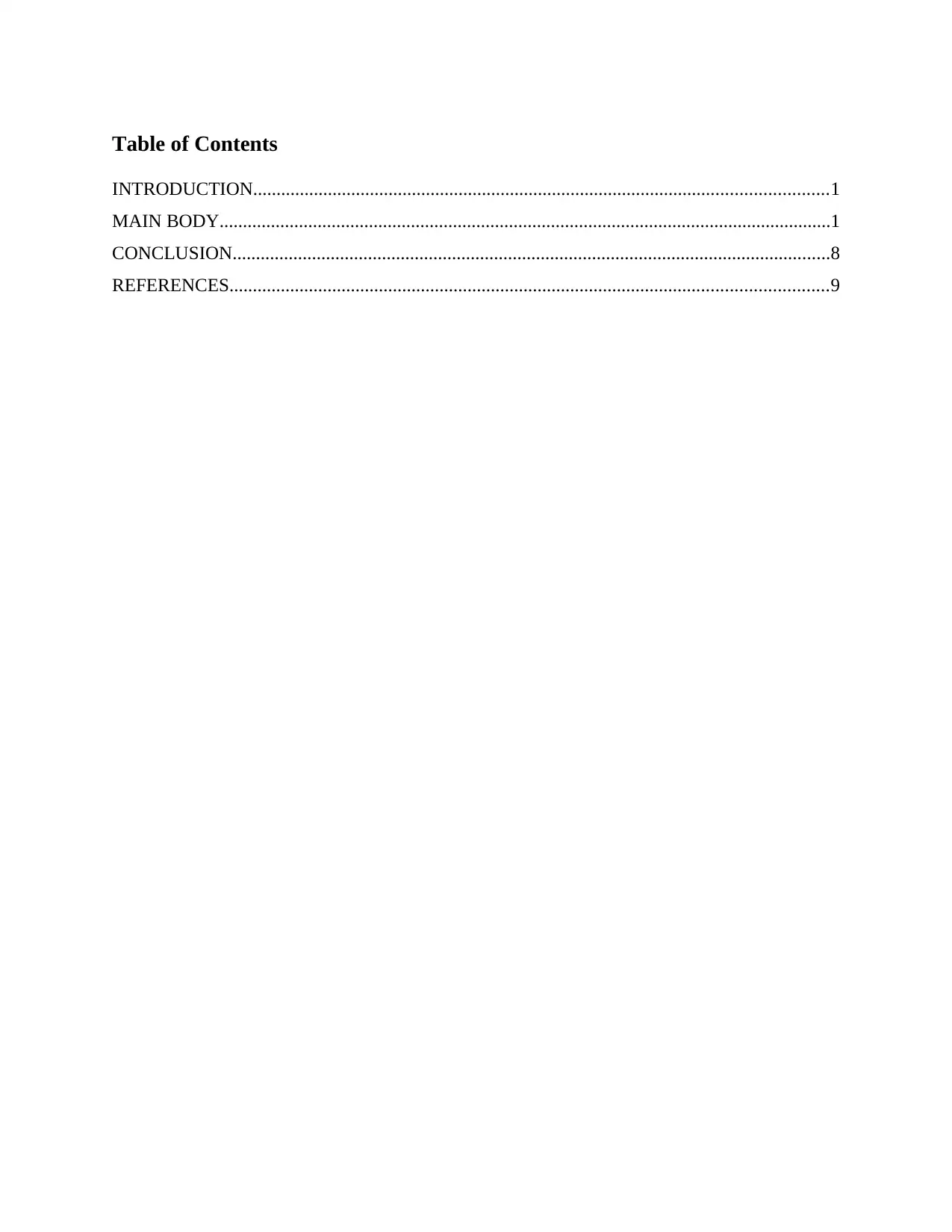
Table of Contents
INTRODUCTION...........................................................................................................................1
MAIN BODY...................................................................................................................................1
CONCLUSION................................................................................................................................8
REFERENCES................................................................................................................................9
INTRODUCTION...........................................................................................................................1
MAIN BODY...................................................................................................................................1
CONCLUSION................................................................................................................................8
REFERENCES................................................................................................................................9
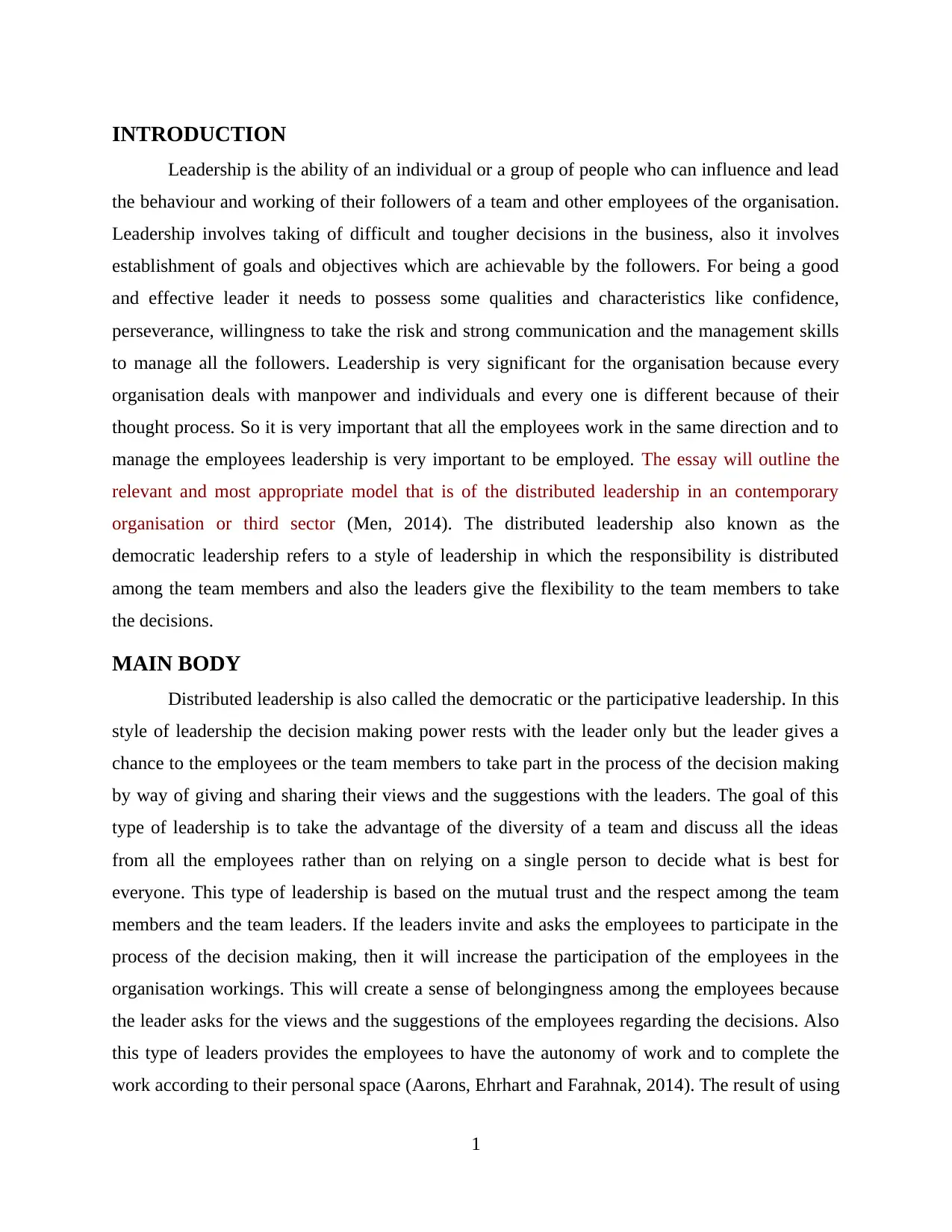
INTRODUCTION
Leadership is the ability of an individual or a group of people who can influence and lead
the behaviour and working of their followers of a team and other employees of the organisation.
Leadership involves taking of difficult and tougher decisions in the business, also it involves
establishment of goals and objectives which are achievable by the followers. For being a good
and effective leader it needs to possess some qualities and characteristics like confidence,
perseverance, willingness to take the risk and strong communication and the management skills
to manage all the followers. Leadership is very significant for the organisation because every
organisation deals with manpower and individuals and every one is different because of their
thought process. So it is very important that all the employees work in the same direction and to
manage the employees leadership is very important to be employed. The essay will outline the
relevant and most appropriate model that is of the distributed leadership in an contemporary
organisation or third sector (Men, 2014). The distributed leadership also known as the
democratic leadership refers to a style of leadership in which the responsibility is distributed
among the team members and also the leaders give the flexibility to the team members to take
the decisions.
MAIN BODY
Distributed leadership is also called the democratic or the participative leadership. In this
style of leadership the decision making power rests with the leader only but the leader gives a
chance to the employees or the team members to take part in the process of the decision making
by way of giving and sharing their views and the suggestions with the leaders. The goal of this
type of leadership is to take the advantage of the diversity of a team and discuss all the ideas
from all the employees rather than on relying on a single person to decide what is best for
everyone. This type of leadership is based on the mutual trust and the respect among the team
members and the team leaders. If the leaders invite and asks the employees to participate in the
process of the decision making, then it will increase the participation of the employees in the
organisation workings. This will create a sense of belongingness among the employees because
the leader asks for the views and the suggestions of the employees regarding the decisions. Also
this type of leaders provides the employees to have the autonomy of work and to complete the
work according to their personal space (Aarons, Ehrhart and Farahnak, 2014). The result of using
1
Leadership is the ability of an individual or a group of people who can influence and lead
the behaviour and working of their followers of a team and other employees of the organisation.
Leadership involves taking of difficult and tougher decisions in the business, also it involves
establishment of goals and objectives which are achievable by the followers. For being a good
and effective leader it needs to possess some qualities and characteristics like confidence,
perseverance, willingness to take the risk and strong communication and the management skills
to manage all the followers. Leadership is very significant for the organisation because every
organisation deals with manpower and individuals and every one is different because of their
thought process. So it is very important that all the employees work in the same direction and to
manage the employees leadership is very important to be employed. The essay will outline the
relevant and most appropriate model that is of the distributed leadership in an contemporary
organisation or third sector (Men, 2014). The distributed leadership also known as the
democratic leadership refers to a style of leadership in which the responsibility is distributed
among the team members and also the leaders give the flexibility to the team members to take
the decisions.
MAIN BODY
Distributed leadership is also called the democratic or the participative leadership. In this
style of leadership the decision making power rests with the leader only but the leader gives a
chance to the employees or the team members to take part in the process of the decision making
by way of giving and sharing their views and the suggestions with the leaders. The goal of this
type of leadership is to take the advantage of the diversity of a team and discuss all the ideas
from all the employees rather than on relying on a single person to decide what is best for
everyone. This type of leadership is based on the mutual trust and the respect among the team
members and the team leaders. If the leaders invite and asks the employees to participate in the
process of the decision making, then it will increase the participation of the employees in the
organisation workings. This will create a sense of belongingness among the employees because
the leader asks for the views and the suggestions of the employees regarding the decisions. Also
this type of leaders provides the employees to have the autonomy of work and to complete the
work according to their personal space (Aarons, Ehrhart and Farahnak, 2014). The result of using
1
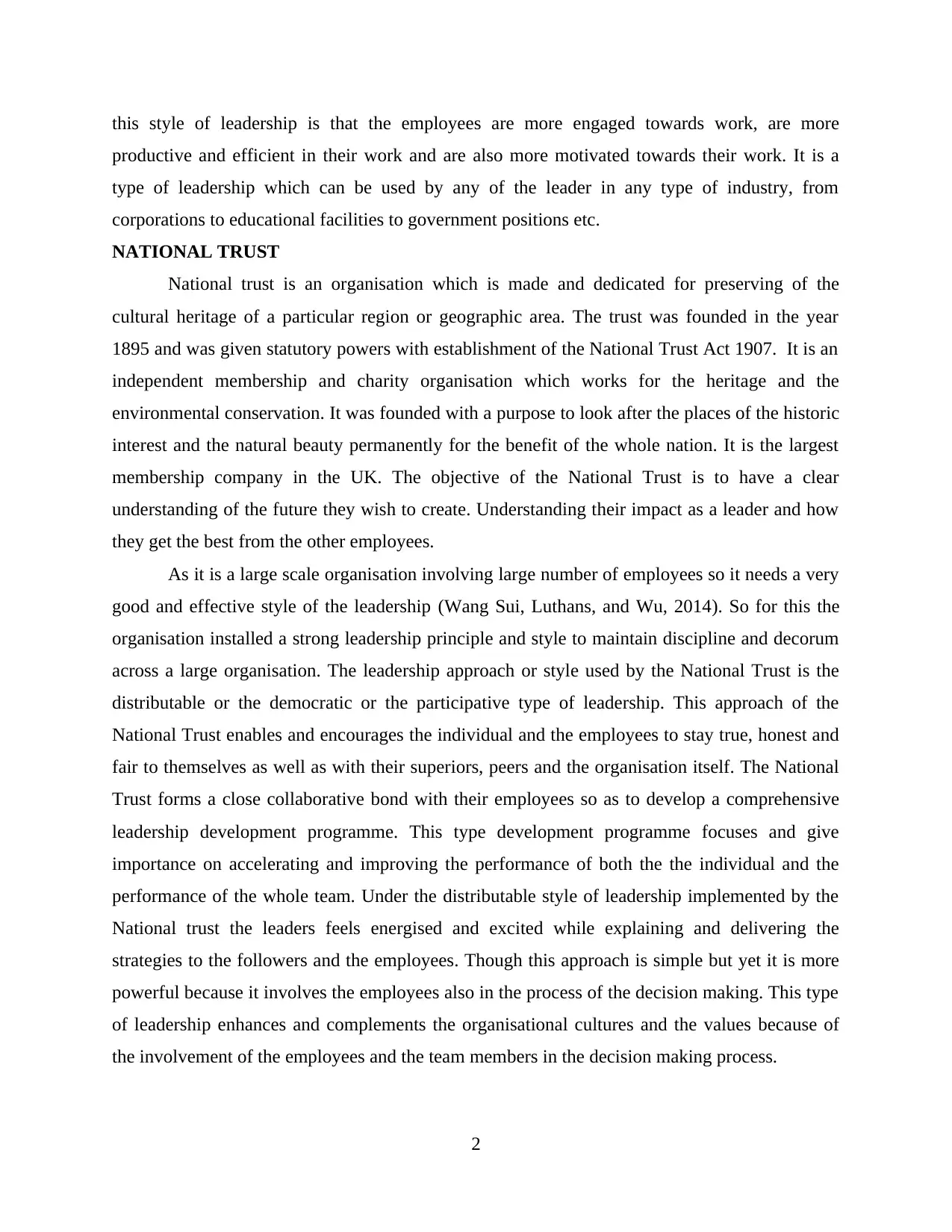
this style of leadership is that the employees are more engaged towards work, are more
productive and efficient in their work and are also more motivated towards their work. It is a
type of leadership which can be used by any of the leader in any type of industry, from
corporations to educational facilities to government positions etc.
NATIONAL TRUST
National trust is an organisation which is made and dedicated for preserving of the
cultural heritage of a particular region or geographic area. The trust was founded in the year
1895 and was given statutory powers with establishment of the National Trust Act 1907. It is an
independent membership and charity organisation which works for the heritage and the
environmental conservation. It was founded with a purpose to look after the places of the historic
interest and the natural beauty permanently for the benefit of the whole nation. It is the largest
membership company in the UK. The objective of the National Trust is to have a clear
understanding of the future they wish to create. Understanding their impact as a leader and how
they get the best from the other employees.
As it is a large scale organisation involving large number of employees so it needs a very
good and effective style of the leadership (Wang Sui, Luthans, and Wu, 2014). So for this the
organisation installed a strong leadership principle and style to maintain discipline and decorum
across a large organisation. The leadership approach or style used by the National Trust is the
distributable or the democratic or the participative type of leadership. This approach of the
National Trust enables and encourages the individual and the employees to stay true, honest and
fair to themselves as well as with their superiors, peers and the organisation itself. The National
Trust forms a close collaborative bond with their employees so as to develop a comprehensive
leadership development programme. This type development programme focuses and give
importance on accelerating and improving the performance of both the the individual and the
performance of the whole team. Under the distributable style of leadership implemented by the
National trust the leaders feels energised and excited while explaining and delivering the
strategies to the followers and the employees. Though this approach is simple but yet it is more
powerful because it involves the employees also in the process of the decision making. This type
of leadership enhances and complements the organisational cultures and the values because of
the involvement of the employees and the team members in the decision making process.
2
productive and efficient in their work and are also more motivated towards their work. It is a
type of leadership which can be used by any of the leader in any type of industry, from
corporations to educational facilities to government positions etc.
NATIONAL TRUST
National trust is an organisation which is made and dedicated for preserving of the
cultural heritage of a particular region or geographic area. The trust was founded in the year
1895 and was given statutory powers with establishment of the National Trust Act 1907. It is an
independent membership and charity organisation which works for the heritage and the
environmental conservation. It was founded with a purpose to look after the places of the historic
interest and the natural beauty permanently for the benefit of the whole nation. It is the largest
membership company in the UK. The objective of the National Trust is to have a clear
understanding of the future they wish to create. Understanding their impact as a leader and how
they get the best from the other employees.
As it is a large scale organisation involving large number of employees so it needs a very
good and effective style of the leadership (Wang Sui, Luthans, and Wu, 2014). So for this the
organisation installed a strong leadership principle and style to maintain discipline and decorum
across a large organisation. The leadership approach or style used by the National Trust is the
distributable or the democratic or the participative type of leadership. This approach of the
National Trust enables and encourages the individual and the employees to stay true, honest and
fair to themselves as well as with their superiors, peers and the organisation itself. The National
Trust forms a close collaborative bond with their employees so as to develop a comprehensive
leadership development programme. This type development programme focuses and give
importance on accelerating and improving the performance of both the the individual and the
performance of the whole team. Under the distributable style of leadership implemented by the
National trust the leaders feels energised and excited while explaining and delivering the
strategies to the followers and the employees. Though this approach is simple but yet it is more
powerful because it involves the employees also in the process of the decision making. This type
of leadership enhances and complements the organisational cultures and the values because of
the involvement of the employees and the team members in the decision making process.
2
Paraphrase This Document
Need a fresh take? Get an instant paraphrase of this document with our AI Paraphraser
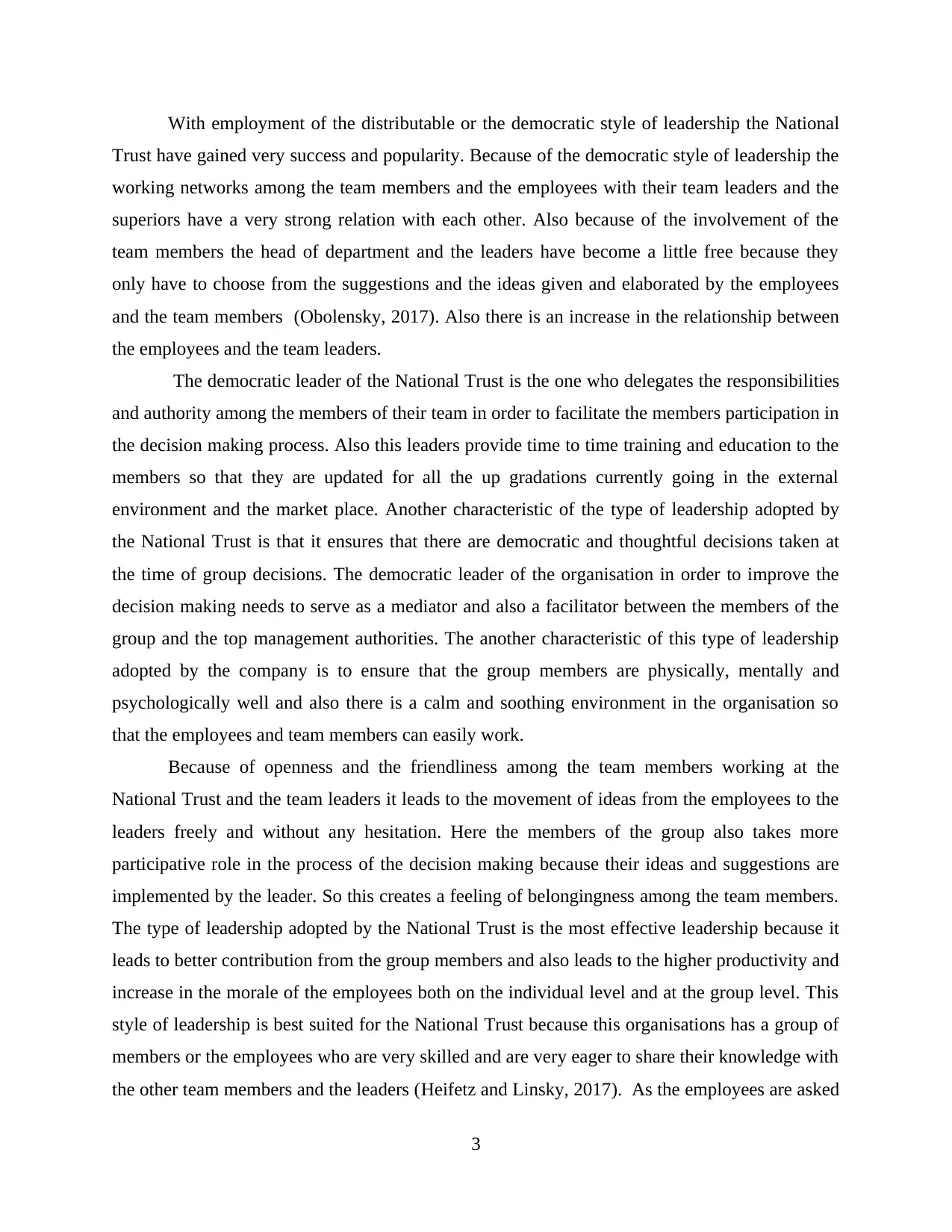
With employment of the distributable or the democratic style of leadership the National
Trust have gained very success and popularity. Because of the democratic style of leadership the
working networks among the team members and the employees with their team leaders and the
superiors have a very strong relation with each other. Also because of the involvement of the
team members the head of department and the leaders have become a little free because they
only have to choose from the suggestions and the ideas given and elaborated by the employees
and the team members (Obolensky, 2017). Also there is an increase in the relationship between
the employees and the team leaders.
The democratic leader of the National Trust is the one who delegates the responsibilities
and authority among the members of their team in order to facilitate the members participation in
the decision making process. Also this leaders provide time to time training and education to the
members so that they are updated for all the up gradations currently going in the external
environment and the market place. Another characteristic of the type of leadership adopted by
the National Trust is that it ensures that there are democratic and thoughtful decisions taken at
the time of group decisions. The democratic leader of the organisation in order to improve the
decision making needs to serve as a mediator and also a facilitator between the members of the
group and the top management authorities. The another characteristic of this type of leadership
adopted by the company is to ensure that the group members are physically, mentally and
psychologically well and also there is a calm and soothing environment in the organisation so
that the employees and team members can easily work.
Because of openness and the friendliness among the team members working at the
National Trust and the team leaders it leads to the movement of ideas from the employees to the
leaders freely and without any hesitation. Here the members of the group also takes more
participative role in the process of the decision making because their ideas and suggestions are
implemented by the leader. So this creates a feeling of belongingness among the team members.
The type of leadership adopted by the National Trust is the most effective leadership because it
leads to better contribution from the group members and also leads to the higher productivity and
increase in the morale of the employees both on the individual level and at the group level. This
style of leadership is best suited for the National Trust because this organisations has a group of
members or the employees who are very skilled and are very eager to share their knowledge with
the other team members and the leaders (Heifetz and Linsky, 2017). As the employees are asked
3
Trust have gained very success and popularity. Because of the democratic style of leadership the
working networks among the team members and the employees with their team leaders and the
superiors have a very strong relation with each other. Also because of the involvement of the
team members the head of department and the leaders have become a little free because they
only have to choose from the suggestions and the ideas given and elaborated by the employees
and the team members (Obolensky, 2017). Also there is an increase in the relationship between
the employees and the team leaders.
The democratic leader of the National Trust is the one who delegates the responsibilities
and authority among the members of their team in order to facilitate the members participation in
the decision making process. Also this leaders provide time to time training and education to the
members so that they are updated for all the up gradations currently going in the external
environment and the market place. Another characteristic of the type of leadership adopted by
the National Trust is that it ensures that there are democratic and thoughtful decisions taken at
the time of group decisions. The democratic leader of the organisation in order to improve the
decision making needs to serve as a mediator and also a facilitator between the members of the
group and the top management authorities. The another characteristic of this type of leadership
adopted by the company is to ensure that the group members are physically, mentally and
psychologically well and also there is a calm and soothing environment in the organisation so
that the employees and team members can easily work.
Because of openness and the friendliness among the team members working at the
National Trust and the team leaders it leads to the movement of ideas from the employees to the
leaders freely and without any hesitation. Here the members of the group also takes more
participative role in the process of the decision making because their ideas and suggestions are
implemented by the leader. So this creates a feeling of belongingness among the team members.
The type of leadership adopted by the National Trust is the most effective leadership because it
leads to better contribution from the group members and also leads to the higher productivity and
increase in the morale of the employees both on the individual level and at the group level. This
style of leadership is best suited for the National Trust because this organisations has a group of
members or the employees who are very skilled and are very eager to share their knowledge with
the other team members and the leaders (Heifetz and Linsky, 2017). As the employees are asked
3
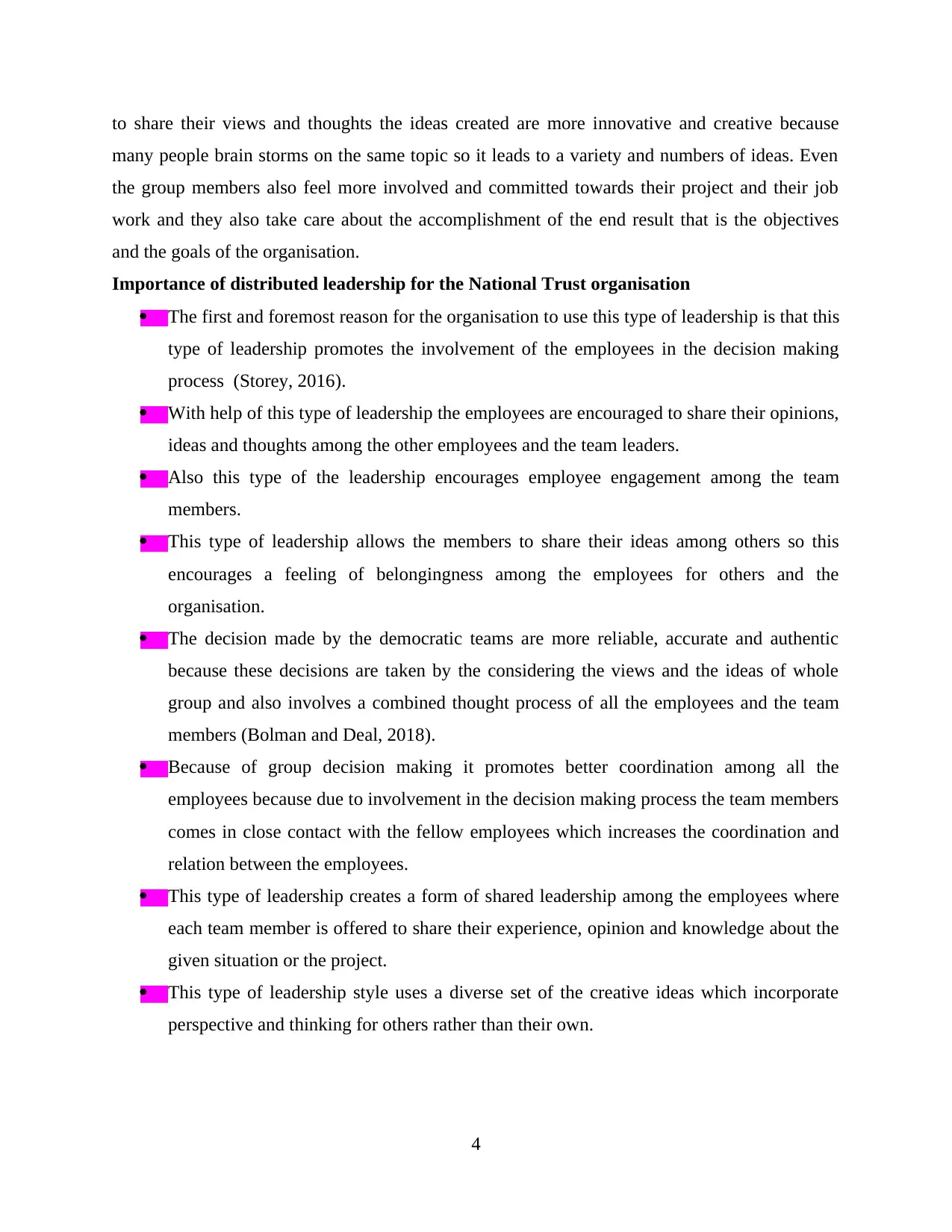
to share their views and thoughts the ideas created are more innovative and creative because
many people brain storms on the same topic so it leads to a variety and numbers of ideas. Even
the group members also feel more involved and committed towards their project and their job
work and they also take care about the accomplishment of the end result that is the objectives
and the goals of the organisation.
Importance of distributed leadership for the National Trust organisation
The first and foremost reason for the organisation to use this type of leadership is that this
type of leadership promotes the involvement of the employees in the decision making
process (Storey, 2016).
With help of this type of leadership the employees are encouraged to share their opinions,
ideas and thoughts among the other employees and the team leaders.
Also this type of the leadership encourages employee engagement among the team
members.
This type of leadership allows the members to share their ideas among others so this
encourages a feeling of belongingness among the employees for others and the
organisation.
The decision made by the democratic teams are more reliable, accurate and authentic
because these decisions are taken by the considering the views and the ideas of whole
group and also involves a combined thought process of all the employees and the team
members (Bolman and Deal, 2018).
Because of group decision making it promotes better coordination among all the
employees because due to involvement in the decision making process the team members
comes in close contact with the fellow employees which increases the coordination and
relation between the employees.
This type of leadership creates a form of shared leadership among the employees where
each team member is offered to share their experience, opinion and knowledge about the
given situation or the project.
This type of leadership style uses a diverse set of the creative ideas which incorporate
perspective and thinking for others rather than their own.
4
many people brain storms on the same topic so it leads to a variety and numbers of ideas. Even
the group members also feel more involved and committed towards their project and their job
work and they also take care about the accomplishment of the end result that is the objectives
and the goals of the organisation.
Importance of distributed leadership for the National Trust organisation
The first and foremost reason for the organisation to use this type of leadership is that this
type of leadership promotes the involvement of the employees in the decision making
process (Storey, 2016).
With help of this type of leadership the employees are encouraged to share their opinions,
ideas and thoughts among the other employees and the team leaders.
Also this type of the leadership encourages employee engagement among the team
members.
This type of leadership allows the members to share their ideas among others so this
encourages a feeling of belongingness among the employees for others and the
organisation.
The decision made by the democratic teams are more reliable, accurate and authentic
because these decisions are taken by the considering the views and the ideas of whole
group and also involves a combined thought process of all the employees and the team
members (Bolman and Deal, 2018).
Because of group decision making it promotes better coordination among all the
employees because due to involvement in the decision making process the team members
comes in close contact with the fellow employees which increases the coordination and
relation between the employees.
This type of leadership creates a form of shared leadership among the employees where
each team member is offered to share their experience, opinion and knowledge about the
given situation or the project.
This type of leadership style uses a diverse set of the creative ideas which incorporate
perspective and thinking for others rather than their own.
4
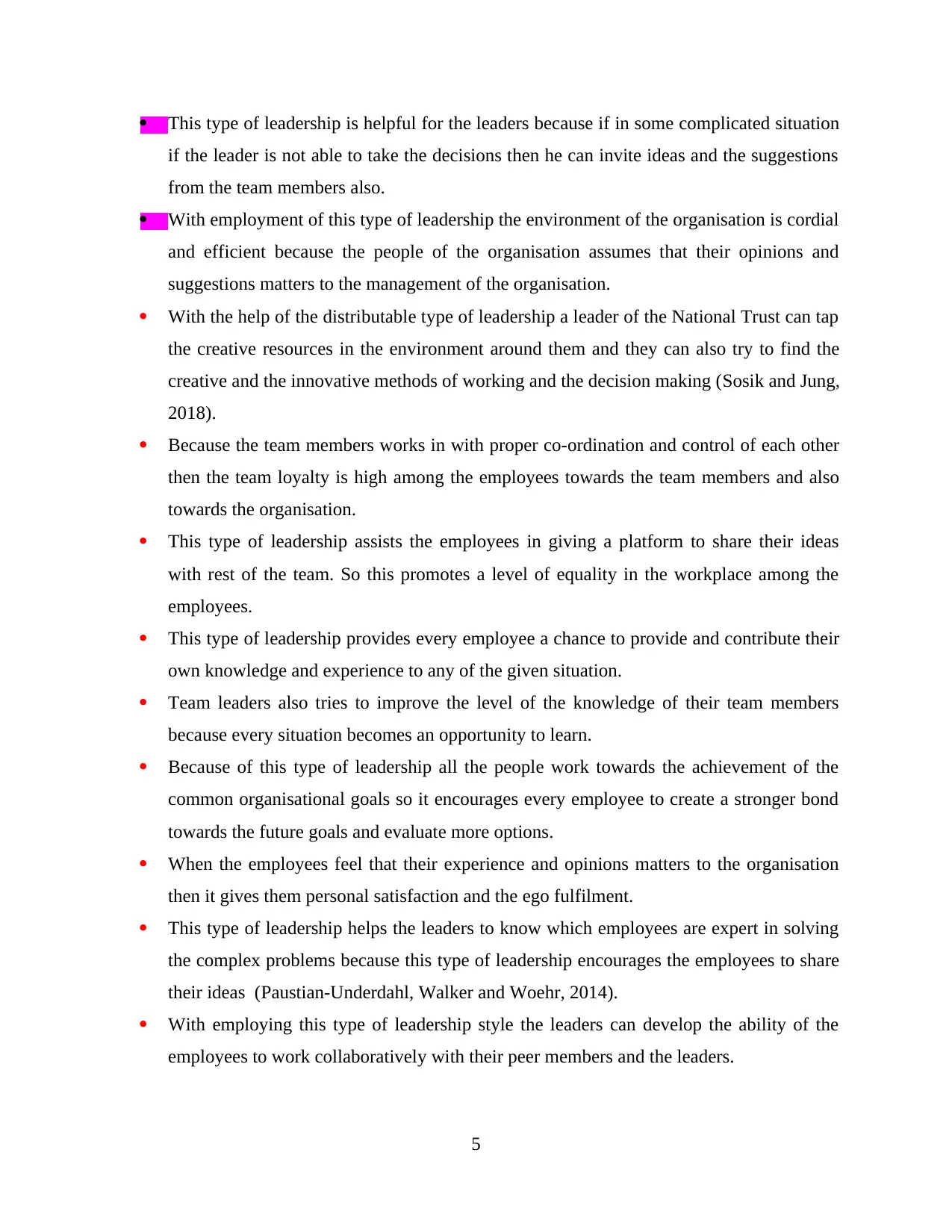
This type of leadership is helpful for the leaders because if in some complicated situation
if the leader is not able to take the decisions then he can invite ideas and the suggestions
from the team members also.
With employment of this type of leadership the environment of the organisation is cordial
and efficient because the people of the organisation assumes that their opinions and
suggestions matters to the management of the organisation.
With the help of the distributable type of leadership a leader of the National Trust can tap
the creative resources in the environment around them and they can also try to find the
creative and the innovative methods of working and the decision making (Sosik and Jung,
2018).
Because the team members works in with proper co-ordination and control of each other
then the team loyalty is high among the employees towards the team members and also
towards the organisation.
This type of leadership assists the employees in giving a platform to share their ideas
with rest of the team. So this promotes a level of equality in the workplace among the
employees.
This type of leadership provides every employee a chance to provide and contribute their
own knowledge and experience to any of the given situation.
Team leaders also tries to improve the level of the knowledge of their team members
because every situation becomes an opportunity to learn.
Because of this type of leadership all the people work towards the achievement of the
common organisational goals so it encourages every employee to create a stronger bond
towards the future goals and evaluate more options.
When the employees feel that their experience and opinions matters to the organisation
then it gives them personal satisfaction and the ego fulfilment.
This type of leadership helps the leaders to know which employees are expert in solving
the complex problems because this type of leadership encourages the employees to share
their ideas (Paustian-Underdahl, Walker and Woehr, 2014).
With employing this type of leadership style the leaders can develop the ability of the
employees to work collaboratively with their peer members and the leaders.
5
if the leader is not able to take the decisions then he can invite ideas and the suggestions
from the team members also.
With employment of this type of leadership the environment of the organisation is cordial
and efficient because the people of the organisation assumes that their opinions and
suggestions matters to the management of the organisation.
With the help of the distributable type of leadership a leader of the National Trust can tap
the creative resources in the environment around them and they can also try to find the
creative and the innovative methods of working and the decision making (Sosik and Jung,
2018).
Because the team members works in with proper co-ordination and control of each other
then the team loyalty is high among the employees towards the team members and also
towards the organisation.
This type of leadership assists the employees in giving a platform to share their ideas
with rest of the team. So this promotes a level of equality in the workplace among the
employees.
This type of leadership provides every employee a chance to provide and contribute their
own knowledge and experience to any of the given situation.
Team leaders also tries to improve the level of the knowledge of their team members
because every situation becomes an opportunity to learn.
Because of this type of leadership all the people work towards the achievement of the
common organisational goals so it encourages every employee to create a stronger bond
towards the future goals and evaluate more options.
When the employees feel that their experience and opinions matters to the organisation
then it gives them personal satisfaction and the ego fulfilment.
This type of leadership helps the leaders to know which employees are expert in solving
the complex problems because this type of leadership encourages the employees to share
their ideas (Paustian-Underdahl, Walker and Woehr, 2014).
With employing this type of leadership style the leaders can develop the ability of the
employees to work collaboratively with their peer members and the leaders.
5
Secure Best Marks with AI Grader
Need help grading? Try our AI Grader for instant feedback on your assignments.
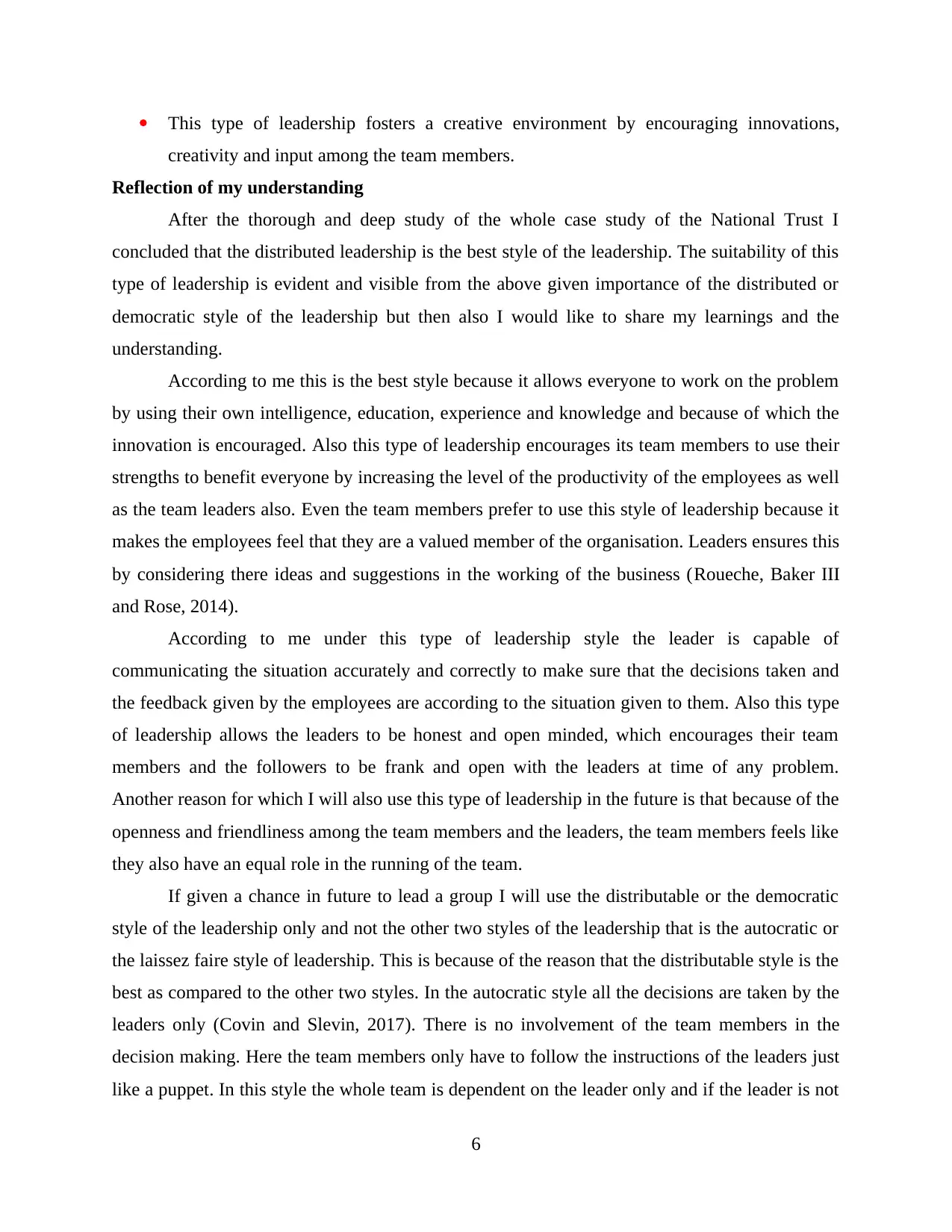
This type of leadership fosters a creative environment by encouraging innovations,
creativity and input among the team members.
Reflection of my understanding
After the thorough and deep study of the whole case study of the National Trust I
concluded that the distributed leadership is the best style of the leadership. The suitability of this
type of leadership is evident and visible from the above given importance of the distributed or
democratic style of the leadership but then also I would like to share my learnings and the
understanding.
According to me this is the best style because it allows everyone to work on the problem
by using their own intelligence, education, experience and knowledge and because of which the
innovation is encouraged. Also this type of leadership encourages its team members to use their
strengths to benefit everyone by increasing the level of the productivity of the employees as well
as the team leaders also. Even the team members prefer to use this style of leadership because it
makes the employees feel that they are a valued member of the organisation. Leaders ensures this
by considering there ideas and suggestions in the working of the business (Roueche, Baker III
and Rose, 2014).
According to me under this type of leadership style the leader is capable of
communicating the situation accurately and correctly to make sure that the decisions taken and
the feedback given by the employees are according to the situation given to them. Also this type
of leadership allows the leaders to be honest and open minded, which encourages their team
members and the followers to be frank and open with the leaders at time of any problem.
Another reason for which I will also use this type of leadership in the future is that because of the
openness and friendliness among the team members and the leaders, the team members feels like
they also have an equal role in the running of the team.
If given a chance in future to lead a group I will use the distributable or the democratic
style of the leadership only and not the other two styles of the leadership that is the autocratic or
the laissez faire style of leadership. This is because of the reason that the distributable style is the
best as compared to the other two styles. In the autocratic style all the decisions are taken by the
leaders only (Covin and Slevin, 2017). There is no involvement of the team members in the
decision making. Here the team members only have to follow the instructions of the leaders just
like a puppet. In this style the whole team is dependent on the leader only and if the leader is not
6
creativity and input among the team members.
Reflection of my understanding
After the thorough and deep study of the whole case study of the National Trust I
concluded that the distributed leadership is the best style of the leadership. The suitability of this
type of leadership is evident and visible from the above given importance of the distributed or
democratic style of the leadership but then also I would like to share my learnings and the
understanding.
According to me this is the best style because it allows everyone to work on the problem
by using their own intelligence, education, experience and knowledge and because of which the
innovation is encouraged. Also this type of leadership encourages its team members to use their
strengths to benefit everyone by increasing the level of the productivity of the employees as well
as the team leaders also. Even the team members prefer to use this style of leadership because it
makes the employees feel that they are a valued member of the organisation. Leaders ensures this
by considering there ideas and suggestions in the working of the business (Roueche, Baker III
and Rose, 2014).
According to me under this type of leadership style the leader is capable of
communicating the situation accurately and correctly to make sure that the decisions taken and
the feedback given by the employees are according to the situation given to them. Also this type
of leadership allows the leaders to be honest and open minded, which encourages their team
members and the followers to be frank and open with the leaders at time of any problem.
Another reason for which I will also use this type of leadership in the future is that because of the
openness and friendliness among the team members and the leaders, the team members feels like
they also have an equal role in the running of the team.
If given a chance in future to lead a group I will use the distributable or the democratic
style of the leadership only and not the other two styles of the leadership that is the autocratic or
the laissez faire style of leadership. This is because of the reason that the distributable style is the
best as compared to the other two styles. In the autocratic style all the decisions are taken by the
leaders only (Covin and Slevin, 2017). There is no involvement of the team members in the
decision making. Here the team members only have to follow the instructions of the leaders just
like a puppet. In this style the whole team is dependent on the leader only and if the leader is not
6
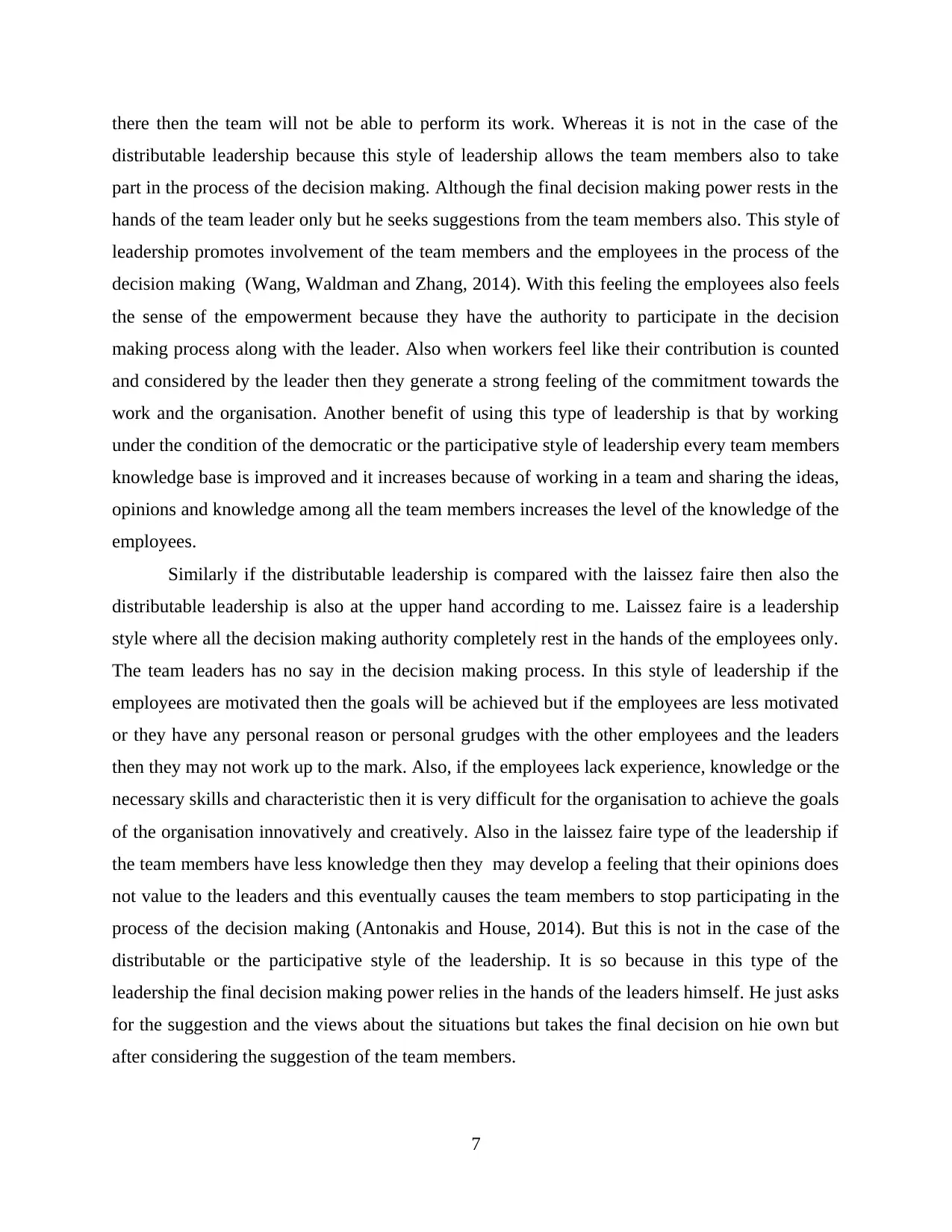
there then the team will not be able to perform its work. Whereas it is not in the case of the
distributable leadership because this style of leadership allows the team members also to take
part in the process of the decision making. Although the final decision making power rests in the
hands of the team leader only but he seeks suggestions from the team members also. This style of
leadership promotes involvement of the team members and the employees in the process of the
decision making (Wang, Waldman and Zhang, 2014). With this feeling the employees also feels
the sense of the empowerment because they have the authority to participate in the decision
making process along with the leader. Also when workers feel like their contribution is counted
and considered by the leader then they generate a strong feeling of the commitment towards the
work and the organisation. Another benefit of using this type of leadership is that by working
under the condition of the democratic or the participative style of leadership every team members
knowledge base is improved and it increases because of working in a team and sharing the ideas,
opinions and knowledge among all the team members increases the level of the knowledge of the
employees.
Similarly if the distributable leadership is compared with the laissez faire then also the
distributable leadership is also at the upper hand according to me. Laissez faire is a leadership
style where all the decision making authority completely rest in the hands of the employees only.
The team leaders has no say in the decision making process. In this style of leadership if the
employees are motivated then the goals will be achieved but if the employees are less motivated
or they have any personal reason or personal grudges with the other employees and the leaders
then they may not work up to the mark. Also, if the employees lack experience, knowledge or the
necessary skills and characteristic then it is very difficult for the organisation to achieve the goals
of the organisation innovatively and creatively. Also in the laissez faire type of the leadership if
the team members have less knowledge then they may develop a feeling that their opinions does
not value to the leaders and this eventually causes the team members to stop participating in the
process of the decision making (Antonakis and House, 2014). But this is not in the case of the
distributable or the participative style of the leadership. It is so because in this type of the
leadership the final decision making power relies in the hands of the leaders himself. He just asks
for the suggestion and the views about the situations but takes the final decision on hie own but
after considering the suggestion of the team members.
7
distributable leadership because this style of leadership allows the team members also to take
part in the process of the decision making. Although the final decision making power rests in the
hands of the team leader only but he seeks suggestions from the team members also. This style of
leadership promotes involvement of the team members and the employees in the process of the
decision making (Wang, Waldman and Zhang, 2014). With this feeling the employees also feels
the sense of the empowerment because they have the authority to participate in the decision
making process along with the leader. Also when workers feel like their contribution is counted
and considered by the leader then they generate a strong feeling of the commitment towards the
work and the organisation. Another benefit of using this type of leadership is that by working
under the condition of the democratic or the participative style of leadership every team members
knowledge base is improved and it increases because of working in a team and sharing the ideas,
opinions and knowledge among all the team members increases the level of the knowledge of the
employees.
Similarly if the distributable leadership is compared with the laissez faire then also the
distributable leadership is also at the upper hand according to me. Laissez faire is a leadership
style where all the decision making authority completely rest in the hands of the employees only.
The team leaders has no say in the decision making process. In this style of leadership if the
employees are motivated then the goals will be achieved but if the employees are less motivated
or they have any personal reason or personal grudges with the other employees and the leaders
then they may not work up to the mark. Also, if the employees lack experience, knowledge or the
necessary skills and characteristic then it is very difficult for the organisation to achieve the goals
of the organisation innovatively and creatively. Also in the laissez faire type of the leadership if
the team members have less knowledge then they may develop a feeling that their opinions does
not value to the leaders and this eventually causes the team members to stop participating in the
process of the decision making (Antonakis and House, 2014). But this is not in the case of the
distributable or the participative style of the leadership. It is so because in this type of the
leadership the final decision making power relies in the hands of the leaders himself. He just asks
for the suggestion and the views about the situations but takes the final decision on hie own but
after considering the suggestion of the team members.
7
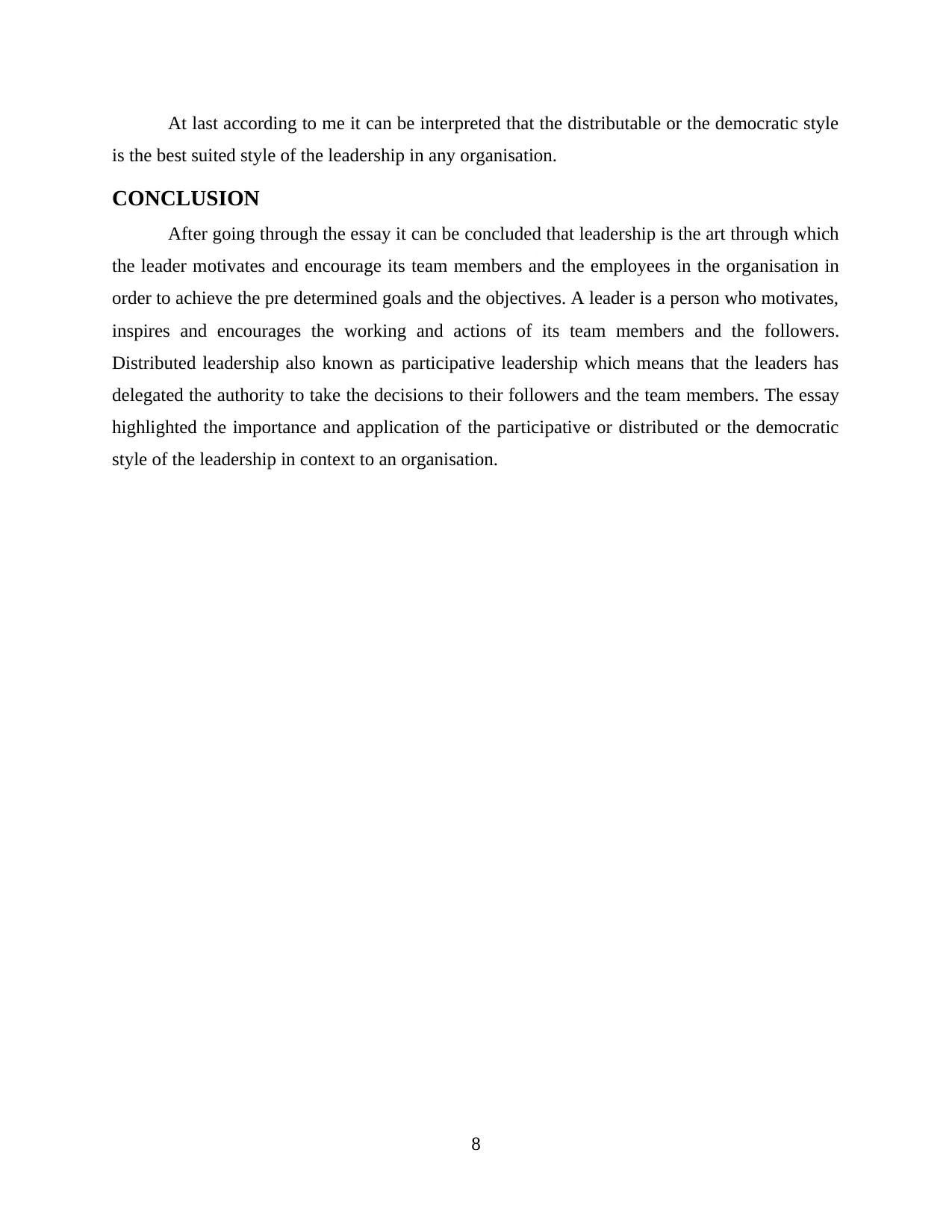
At last according to me it can be interpreted that the distributable or the democratic style
is the best suited style of the leadership in any organisation.
CONCLUSION
After going through the essay it can be concluded that leadership is the art through which
the leader motivates and encourage its team members and the employees in the organisation in
order to achieve the pre determined goals and the objectives. A leader is a person who motivates,
inspires and encourages the working and actions of its team members and the followers.
Distributed leadership also known as participative leadership which means that the leaders has
delegated the authority to take the decisions to their followers and the team members. The essay
highlighted the importance and application of the participative or distributed or the democratic
style of the leadership in context to an organisation.
8
is the best suited style of the leadership in any organisation.
CONCLUSION
After going through the essay it can be concluded that leadership is the art through which
the leader motivates and encourage its team members and the employees in the organisation in
order to achieve the pre determined goals and the objectives. A leader is a person who motivates,
inspires and encourages the working and actions of its team members and the followers.
Distributed leadership also known as participative leadership which means that the leaders has
delegated the authority to take the decisions to their followers and the team members. The essay
highlighted the importance and application of the participative or distributed or the democratic
style of the leadership in context to an organisation.
8
Paraphrase This Document
Need a fresh take? Get an instant paraphrase of this document with our AI Paraphraser
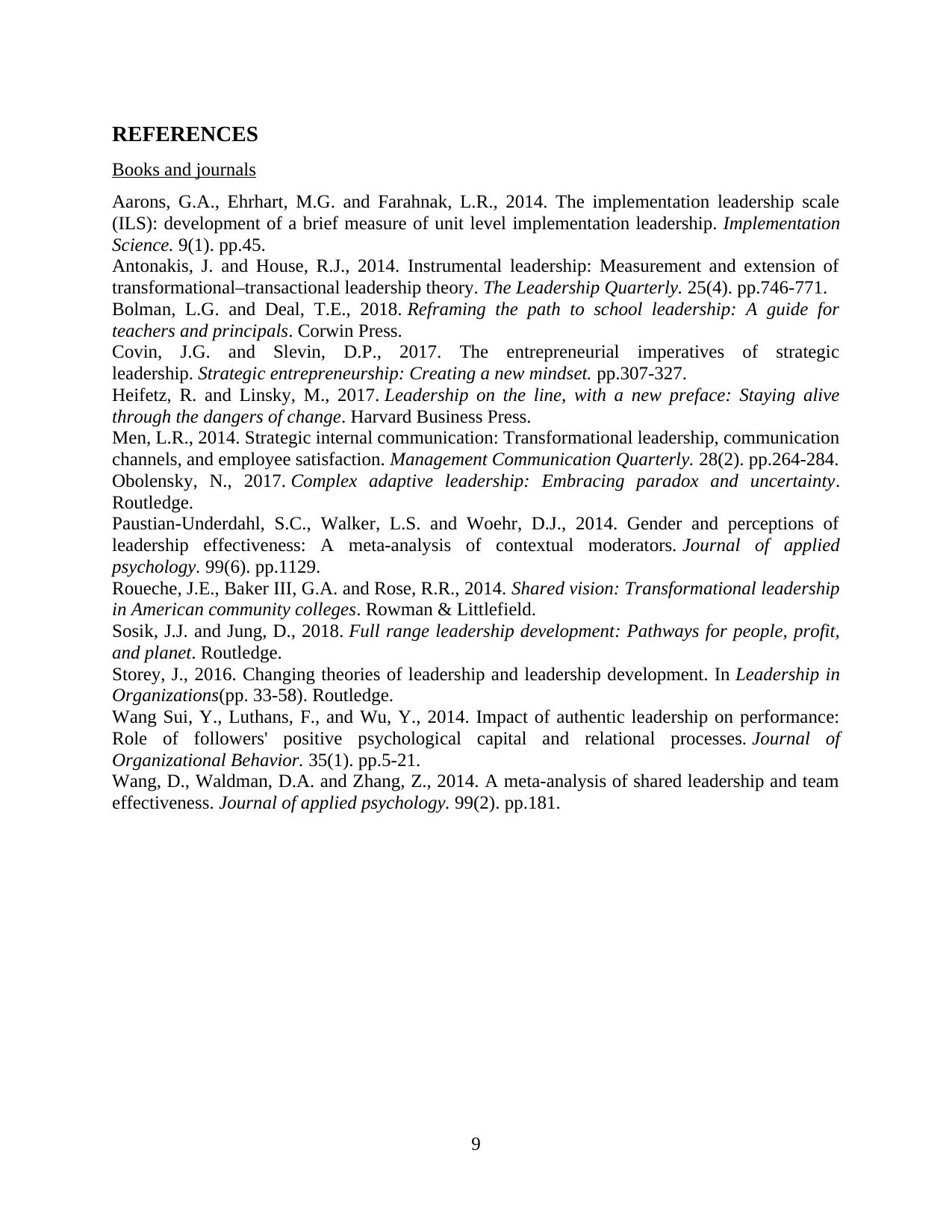
REFERENCES
Books and journals
Aarons, G.A., Ehrhart, M.G. and Farahnak, L.R., 2014. The implementation leadership scale
(ILS): development of a brief measure of unit level implementation leadership. Implementation
Science. 9(1). pp.45.
Antonakis, J. and House, R.J., 2014. Instrumental leadership: Measurement and extension of
transformational–transactional leadership theory. The Leadership Quarterly. 25(4). pp.746-771.
Bolman, L.G. and Deal, T.E., 2018. Reframing the path to school leadership: A guide for
teachers and principals. Corwin Press.
Covin, J.G. and Slevin, D.P., 2017. The entrepreneurial imperatives of strategic
leadership. Strategic entrepreneurship: Creating a new mindset. pp.307-327.
Heifetz, R. and Linsky, M., 2017. Leadership on the line, with a new preface: Staying alive
through the dangers of change. Harvard Business Press.
Men, L.R., 2014. Strategic internal communication: Transformational leadership, communication
channels, and employee satisfaction. Management Communication Quarterly. 28(2). pp.264-284.
Obolensky, N., 2017. Complex adaptive leadership: Embracing paradox and uncertainty.
Routledge.
Paustian-Underdahl, S.C., Walker, L.S. and Woehr, D.J., 2014. Gender and perceptions of
leadership effectiveness: A meta-analysis of contextual moderators. Journal of applied
psychology. 99(6). pp.1129.
Roueche, J.E., Baker III, G.A. and Rose, R.R., 2014. Shared vision: Transformational leadership
in American community colleges. Rowman & Littlefield.
Sosik, J.J. and Jung, D., 2018. Full range leadership development: Pathways for people, profit,
and planet. Routledge.
Storey, J., 2016. Changing theories of leadership and leadership development. In Leadership in
Organizations(pp. 33-58). Routledge.
Wang Sui, Y., Luthans, F., and Wu, Y., 2014. Impact of authentic leadership on performance:
Role of followers' positive psychological capital and relational processes. Journal of
Organizational Behavior. 35(1). pp.5-21.
Wang, D., Waldman, D.A. and Zhang, Z., 2014. A meta-analysis of shared leadership and team
effectiveness. Journal of applied psychology. 99(2). pp.181.
9
Books and journals
Aarons, G.A., Ehrhart, M.G. and Farahnak, L.R., 2014. The implementation leadership scale
(ILS): development of a brief measure of unit level implementation leadership. Implementation
Science. 9(1). pp.45.
Antonakis, J. and House, R.J., 2014. Instrumental leadership: Measurement and extension of
transformational–transactional leadership theory. The Leadership Quarterly. 25(4). pp.746-771.
Bolman, L.G. and Deal, T.E., 2018. Reframing the path to school leadership: A guide for
teachers and principals. Corwin Press.
Covin, J.G. and Slevin, D.P., 2017. The entrepreneurial imperatives of strategic
leadership. Strategic entrepreneurship: Creating a new mindset. pp.307-327.
Heifetz, R. and Linsky, M., 2017. Leadership on the line, with a new preface: Staying alive
through the dangers of change. Harvard Business Press.
Men, L.R., 2014. Strategic internal communication: Transformational leadership, communication
channels, and employee satisfaction. Management Communication Quarterly. 28(2). pp.264-284.
Obolensky, N., 2017. Complex adaptive leadership: Embracing paradox and uncertainty.
Routledge.
Paustian-Underdahl, S.C., Walker, L.S. and Woehr, D.J., 2014. Gender and perceptions of
leadership effectiveness: A meta-analysis of contextual moderators. Journal of applied
psychology. 99(6). pp.1129.
Roueche, J.E., Baker III, G.A. and Rose, R.R., 2014. Shared vision: Transformational leadership
in American community colleges. Rowman & Littlefield.
Sosik, J.J. and Jung, D., 2018. Full range leadership development: Pathways for people, profit,
and planet. Routledge.
Storey, J., 2016. Changing theories of leadership and leadership development. In Leadership in
Organizations(pp. 33-58). Routledge.
Wang Sui, Y., Luthans, F., and Wu, Y., 2014. Impact of authentic leadership on performance:
Role of followers' positive psychological capital and relational processes. Journal of
Organizational Behavior. 35(1). pp.5-21.
Wang, D., Waldman, D.A. and Zhang, Z., 2014. A meta-analysis of shared leadership and team
effectiveness. Journal of applied psychology. 99(2). pp.181.
9
1 out of 11
![[object Object]](/_next/static/media/star-bottom.7253800d.svg)





